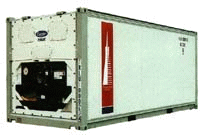Links
Resources
Ocean Shipping Containers
This information is provided as a guide, to help you in determining the type of shipping container best suited to your needs. It is important to notice that some of these specs will vary from container to container, depending on the type of construction, the manufacturer, the age, etc. Please confirm your measurements when making a booking. (In particular, please note that the cubic capacity of these containers is shown as an absolute maximum…the amount of AIR or water that would fit in a container. As shipping cartons are always different sizes and shapes, your actual capacity can be substantially below these figures.
Dry Containers

Dry , or standard , containers are basically steel boxes, either 40′ or 20′ long, by 8′ wide by 8’6” high. Two steel doors on one end open (almost the full dimensions of the container) to allow loading and unloading, either by hand or by forklift.
Open Top Containers

Open Top containers, are basically a dry container, with the roof removed. In place of the steel roof, is a tarp, which can be removed for loading or unloading the container from above (ie: a crane), or can be left open to accommodate cargo that is OVERHEIGHT (see also flatrack containers )
High Cube Containers

As the name implies, HIGH CUBE containers are containers that provide EXTRA height inside. High cubes are the same basic dimensions as a standard dry container, but are , outside, 9’6” high, giving you 1 foot of extra cargo space. High cube containers are used to accommodate large, bulky but not very dense (heavy) cargo. High cubes are a good way to maximize your shipping cost per cu.ft or unit, as the rate difference is not very significant vs. a standard height container. High Cube containers are also available in 45 foot (and sometimes , 48 foot) lengths.
Flat Rack Containers

Flat racks (and platform) containers are probably the most unique of all shipping containers, and are very much a specialty shipping device. Used for shipping equipment, industrial machines, boats, etc. these containers are basically just ‘platforms’ on which goods are loaded, and then strapped or tied down. This allows shipping of goods that would normally move as ‘bulk’ goods, as a containerized unit, saving on costs for trucking, loading, handling, etc. Flat Rack containers generally have a floor, and two bulkheads, one at each end. Some of them, like the one in the picture, have ends that fold down. Others have only 4 corner posts, and some have FIXED ends. Platform containers are basically flat rack containers with NO bulkheads or posts…just a 20′ x 8′ or 40′ x 8′ piece of steel .
RefrigeratedContainers

Refrigerated containers are similar to dry containers, with the exception that they include a built in refrigeration unit to keep perishable goods cold or frozen. There are many different kinds of refrigerated containers – some with self contained, diesel powered cooling units, some with electric units that are plugged into ships power, dock power and generator units carried by trucking companies. As well as keeping goods cool, these containers are often used to keep goods from freezing in harsh climates, such as the Canadian Prairies.
Contact TDK or your Freight Forwarder/Shipping Line for further details on refrigerated containers
Assorted Documents
- Canadian Procedures for Containers Required by Solas V1/2
- Construction Environmental Management Plan – Draft
- Drawing Package
- Empty Acceptance
- Engagement Summary Report – August 2023
- Environmental Air Assessment
- Environmental Noise and Vibration Assessment
- Feedback Form – May 2023
- Fire Safety Plan
- Flood Vulnerability Assessment
- Geotechnical Investigation Report
- Hazardous Materials Inspection Report
- Public notification letter – May 2023
- Rail Operating Plan
- Stormwater Pollution Prevention Plan (draft)
- Supplementary Information Report
- TDK Container Yard Operations Traffic Plan 05/14/2019
- Traffic Impact Assessment
- Transport Canada Ship Safety Bulletin – 04/16
Links
About TDK METRO Terminals
Bulletin Board
Our Testimonials
Great, excellent, wonderful
Fatima Uio
Great service. Helpful staff.
JAMES Cousineau
I will use them again for sure.
Wayne Burkart
Contact Us
- Our address: #10 - 480 Audley Blvd., Delta, BC, V3M 5S4, Canada
- WH Phone : 604-515-4806
- WH Fax : 604-515-4807
- 7:30am to 4:00pm
- Holiday Hours
- Dec 26th : Closed
- Dec 27th : Closed
- Jan 2nd : Closed
- CY Phone: 604-515-4864
- 7:30am to 4:00pm
- Sat & Sun: Closed
- *Extended hours and weekend shift available upon request*





